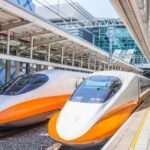
The North-South high-speed railway has fully calculated the connection plan with existing railways and the planning of urban railway networks.
|
According to the Vietnam Railway Authority (under the Ministry of Transport), the pre-feasibility report for the North-South high-speed railway project has thoroughly considered the connection with existing railways and the planning of urban railway networks in Hanoi and Ho Chi Minh City.
Seamless Connection with Existing Railways and Urban Transit
In the northern region, from the Ngoc Hoi complex and Thuong Tin station, the high-speed railway will connect with the northern national railways, including the routes from Lao Cai to Hanoi and Haiphong and from Hanoi to Lang Son. These connections will be facilitated through the eastern belt railway, for which a pre-feasibility study report is being prepared, and the western belt railway, which has already been planned.
The line will link to the center of Hanoi via the urban railway line 1 and connect to Noi Bai International Airport through the urban railway line 6. It will also provide access to the seaport area of Haiphong, facilitating international freight transport to China via the Lao Cai-Hanoi-Haiphong and Hanoi-Lang Son routes.
In central Vietnam, the high-speed railway will connect with Laos for international freight transport at Vung Ang station through the Mu Gia-Vung Ang-Vientiane route. At Chu Lai station, it will link to Chu Lai Airport, which is envisioned as the freight transport hub for central Vietnam.
The line will provide connections to Vung Ang and Ky Ha seaports through dedicated freight stations at Vung Ang and Chu Lai, respectively. Additionally, in the central region, the high-speed railway has been planned to connect with the trans-Central Highlands railway at Da Nang station.
In the southern region, the high-speed railway will integrate with the Ho Chi Minh City node network and the Cai Mep- Thi Vai seaport through the Bien Hoa- Vung Tau line, which intersects at the Trang Bom high-speed railway station. It will also facilitate international freight transport to Cambodia via the Ho Chi Minh City-Lộc Ninh route and connect to the Mekong Delta region through the Ho Chi Minh City- Can Tho line.
From Thu Thiem station, the southern terminus of the North-South high-speed railway, the line will connect to the center of Ho Chi Minh City and Tan Son Nhat International Airport via urban railway lines. It will also provide a direct link to Long Thanh International Airport at Long Thanh station.
“The route and station locations have been agreed upon by local authorities and are in line with provincial planning. They offer convenient connections to urban centers through road systems. The project is expected to invest in approximately 13km of roads, with 4-6 lanes, to link each station to the local road network,” said the representative from the Vietnam Railway Authority.
International Freight Transport and Efficient Cargo Handling
Regarding connection options, the planning aims to have the North-South high-speed railway originate at the Ngoc Hoi hub station in the north and terminate at the Thu Thiem station in the south. Passenger pick-up, drop-off, and connections to the urban core will be facilitated through urban railways, regional railways, and public transportation.
For instance, the Ngoc Hoi hub will offer connections through urban railway lines 1 and 6, while the Thu Thiem terminus will link to the city center via urban railway lines 2 and 10, as well as the Thu Thiem-Long Thanh regional railway.
At the Ngoc Hoi passenger station in Hanoi, approximately 250 hectares will be allocated for the development of a comprehensive national and urban hub, including various necessary functions.
The Ngoc Hoi area will feature a well-connected transportation system, including Ring Roads 3.5 and 4, National Highway 1, three urban railway lines (1, 1A, and 6), a bus system, and a square to accommodate taxis and private vehicles. This integrated system, along with connections to the existing North-South national railway, the eastern and western belt railways, will ensure efficient and convenient passenger dispersal for the high-speed railway.
In the Ho Chi Minh City node area, the Thu Thiem station will also benefit from a well-connected transportation network, including Ring Roads 3.5 and 4, National Highway 1, three urban railway lines, the Thu Thiem-Long Thanh regional railway, and a bus system. These connections will facilitate the swift dispersal of high-speed railway passengers. The Long Truong area will be designated for maintenance, repair, and parking of high-speed trains.
Regarding international freight transport, consultants shared that it is mainly connected through the northern region to the Chinese railway network, from where it can reach third countries and Europe via two routes: Hanoi-Dong Dang and Hanoi-Lao Cai.
The existing Hanoi-Dong Dang railway has a dual-gauge track, accommodating both 1,000mm and 1,435mm gauge trains. The Hanoi-Lao Cai route currently has a 1,000mm gauge, but a new 1,435mm gauge railway from Lao Cai to Hanoi to Haiphong is being planned as per the approved master plan.
The demand for international freight transport along the North-South corridor primarily includes textiles, consumer goods, electronics, and fresh produce. High-speed rail is expected to cater to lightweight, high-value cargo, such as express delivery items.
When there is a need for international freight transport, goods can be transported through five dedicated freight stations along the high-speed railway at Thuong Tin (Hanoi), Vung Ang (Ha Tinh), Chu Lai (Quang Nam), Ninh Hoa (Khanh Hoa), and Trang Bom (Dong Nai). If required, to connect with the existing 1,000mm gauge railways, transshipment equipment can be arranged at the hub stations to facilitate the transfer of goods between the two gauge systems.
“International experience shows that transshipment equipment can be installed to facilitate the transfer of goods between the 1,000mm and 1,435mm gauge systems. With this equipment, it takes only about an hour to clear a 2,000-ton train. This technology has been designed and will be implemented at the Trảng Bom station as part of the Biên Hòa-Vũng Tàu railway project,” the consultant shared.
“Proposed Approval of the $7.6 Billion Lao Cai – Quang Ninh Railway”
The Vietnam Railways Administration has proposed to the Ministry of Transport for approval of the Laos Cai – Hanoi – Hai Phong – Quang Ninh railway line, with a total investment of over VND 179,000 billion. This ambitious project aims to revolutionize transportation in the region, offering a seamless connection between these major cities and opening up new opportunities for economic growth and development.
“High-Speed Rail Project: Presenting the Vision for a 350km/h North-South Corridor in Vietnam”
The Vietnam Railways Authority has confirmed that the Ministry of Transport has submitted a proposal for a high-speed North-South railway to the Government Party Committee for approval by the Politburo. The Ministry is expediting the completion of the project’s pre-feasibility study report, aiming to present it to the National Assembly for their consideration and investment decision during their upcoming October session.



















